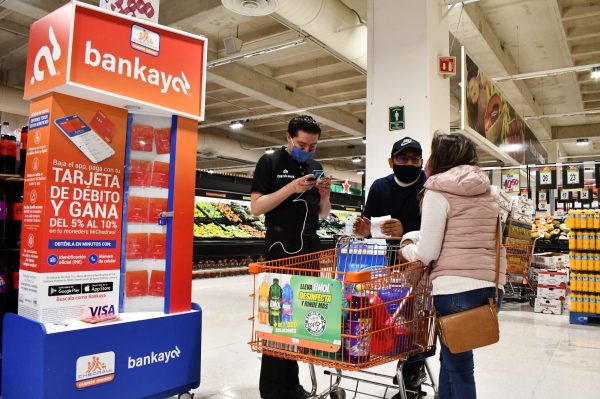Most fintechs pride themselves on digital everything, including customer acquisition strategy.
But Bankaya, a Mexico City-based financial services startup, is attributing its early traction on the opposite model — going after target customers in person.
Founded in 2019 by CEO Mauricio Cordero, Ramón Chedraui and Diego Vargas, Bankaya launched one year ago and boasted 450,000 customers as of year’s end. Impressively, and perhaps counterintuitively, most of that customer acquisition was via offline channels.
Bankaya’s target customers are the 50 million unbanked in Mexico. And the startup has made it its mission to drastically lower that number with what it believes is a unique approach.
“We realized we can’t reach this segment digitally. We have to go offline, face to face,” he told TechCrunch. “Especially because many of our target customers live in rural or remote areas, doing things like saving money under the mattress.”
Quite literally, Bankaya’s salesforce works the streets, even setting up shop at places like supermarkets and vaccination centers flanked by kiosks filled with debit cards.
“The underserved need a lot of handholding, someone in front of them explaining how to use a card, for example, or how to send money to family,” Cordero said. “They are usually not active online and they are not going to download an app out of Facebook or Instagram.”
That human engagement is working wonders. In December, Bankaya processed more than 800,000 transactions from customers, including purchases, deposits, withdrawals, bank transfers and payments of services. That’s up from over 500,000 in October. Its target population has an inherent distrust of traditional banks, hence the strategy of talking to people face to face with the goal of easing some of that hesitation.
“We’re working with the truly unbanked customer,” Cordero explained. “So we’re about building trust and financial education. The human element in these cases is so important. Just really critical. And that impact agenda is our competitive advantage.”
Cordero estimates that Bankaya’s CAC (customer acquisition cost) is about $4 per account opened — likely far lower than that of most fintechs and traditional banks.
“Every single digital bank in Mexico is spending millions on Facebook and Google ads, and that’s driving up their acquisition costs,” he told TechCrunch. “They’re all going after the same customer, and in a very expensive way that results in low-quality conversion rates and engagement.”
Another crucial differentiator for Bankaya is the fact that it is built via a BaaS (banking as a service) platform. There are only about 50 fully-licensed banks in all of Mexico and the country rarely awards new banking licenses, noted Cordero. “Then you have the IFPEs, or wallets, via the fintech law.“
“We’re something in between,” explains Cordero. “We’re one of the first BaaS platforms connected to one of the 50 banks, and that has allowed us to have a really strong product. Fintech laws say that IFPEs are not allowed to touch consumer deposits — they can’t lend with them or share returns. But we are allowed to because we use the BaaS license of Consubanco.”
Its app has a digital card that is free for the user. The startup has a loyalty partnership with Chedraui, one of the country’s largest retailers. If Bankaya users buy goods in stores with their debit cards, they get 5% to 10% cash back on their Chedraui wallet. (Co-founder Ramón Chedraui is one of the family members that own Grupo Chedraui).
So far, 55% of Bankaya’s customers are women, and 59% earn an income below the national average of $600 a month. Sixty-nine percent don’t have a credit card. Over half of its customers are funded within the first three days of opening an account and all receive a digital card upon signing up, according to Cordero. The startup also offers a 2.5% return on deposits.
“Driving engagement is the name of the game for neobanks,” he told TechCrunch. “It can be hard to monetize if customers don’t see real value. For Bankaya, it doesn’t matter who you are or where you’re coming from, we want to help give people financial freedom so they don’t have to do things like walk two hours to pay a utility bill.”
Meanwhile, over time, the startup will gather data that will only assist with future credit analysis.
To date, Bankaya is bootstrapped, funded by its founders, two of whom don’t participate in day to day operations. It has about 100 employees and a salesforce of about 300.
Bankaya is also launching a buy now, pay later platform so that customers, through its app, can get credit installments. It won’t work as a credit card and the startup is not onboarding merchants. It works directly with the customers.
“They use a debit card to buy a product and pay Bankaya over time,” Cordero said. Unlike with traditional buy now, pay later offerings, the startup does charge interest.
“This is not Germany or the U.S. where you can offer BNPL at 0% interest. That’s extremely hard to do here,” Cordero said. “We have to charge interest but the idea is to graduate customers so that once someone pays off an item, they can finance the second item with a lower interest rate.”
